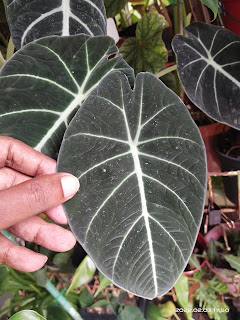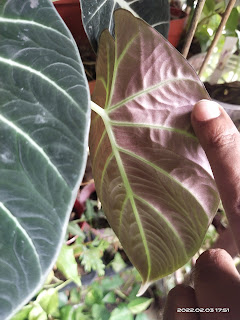INTRODUCTION:
In comparison to all the Alocasia species listed, this particular one is considered a Jewel.
It is not a hardy plant and may easily succumb to stem & root rot if overwatered - the succulent features of these plant - where the leaves are very much have a hard texture almost like a shield - a leather thick foliage.
These have a dark, almost black foliage with brilliant silvery-white veins sunken deep inside the leaf surface. Indeed a unique type indeed.
I had challenges with this one.
Killed if few times - got it right for many months and still end up killing it as I took it for granted.
This one is similar behavior with Caladium - always in the balance of everything - not too much of everything.
CHARACTERISTICS:
There have been some confusion concerning the true identification - unless you have both plant side by side, it is going to be quite difficult to actually note the difference. However, after careful investigation, I have managed to put a video together to actually see the real difference.
I also noticed that many people and collectors are quick to label both 'Black Velvet' and 'Black Ninja' as the same plant - however, the name identification can also be challenging when reputable nurseries mis-identify them without proper research.
However - this is very much 'Black Ninja' the white central mid-rib are much elaborate and thick in comparison to 'Black Velvet' also the back of the leaves have different features than the latter.
Do view the video as you can see the side by side difference between both plants:
Difference between Alocasia Black 'Ninja' & Alocasia Reginula 'Black Velvet'
LIGHT:
One of the Main factor is Lighting - they require good indirect bright light - neither exposed to direct hot sun and that will scorch the leaves also not total indoor shaded area as it will make the leaves grow leggy and pale looking.
An ideal lighting would be like few hours of morning sun shaded away from direct rain as these will not do well when exposed to open direct rain water.
POTTING MEDIUM:
I often find this one grown and cultivated inside a cocopeat and end up killing it when overwatering it. And thus removing the access cocopeat and mix the medium 50% coco-chip with 50% sand to create the fast draining factor for watering purpose.
Also I would layer the bottom draining hole with cotton fiber and put 2-3 tablespoon of compost. I came to know that vermi-compost would be the best however if you can get those, a regular compost will do. Make sure you put those at the bottom and then later the sand and coco-chip - layering the root ball carefully as not to direct expose them to the compost.
Another factor is that the medium needs to be fast draining - the river sand and the coconut chip seemed to be the best I had found so far that doesn't kill the plant over time. In comparison to so many other potting medium which I had bad results where the plant suddenly dies due to accidentally overwatering over too dry a medium that cannot hold moisture - this is the best alternative medium that I had found so far that works.
There are other suggestions where perlite, pumice and a mixture of cocopeat are also used together, if it does work for you - then I guess it had acclimated and suited to your garden conditions. I must say that my garden conditions are too wet, hence it is not possible - as it can easily cause root and tuber rot.
Also please note - the rot is not visible until it is too late - even the leaves will look sturdy and without damage especially the top crown. Once the rot had taken full damage where the tuber appears to turn into a mush - the plant is totally doomed even though the top crown appears unaffected.
WATERING:
Overwatering is the main reason why this plant dies - do be very concern about this matter. The rule of the thumb is to water it 3-4 days once or to check with a poke test to see whether to medium is dry before the next watering. The best would be at least 30% of the top soil is dry before the next application.
Again, this correspond very much together with the medium used as the potting medium. Again - a lot of trial and error make take place until you get this part right. Once you have succeed in cultivating the right watering and the correct medium for this plant that suit your garden condition, I would truly recommend to get the rest of the different species in your collection as you know they are quite pricey and not easy to come by.
However I have also noticed that most of these plants do come in huge bulk as they are cultivated using tissue culture making their prices cheaper and very much affordable in comparison to the grown tuber counter-parts which may take years and propagated using corms that been produced by the parent plant.
This may be one of the reason why this plant is still considered rare due to the slow growing process and their sensitivity when they suddenly die due to wrong plant care cultivation.
FERTILIZER:
Once the Plant had established itself it is a good growing cycle, you can rest assured that there will be a new leaf growth in each new month and that will last at least for 3-4 months before the leaf matures and dries off.
Regular weekly foliar fertilizer would be the best for this one. I had come across some gardeners use osmocote for this particular plant - however, it can be unpredictable when you would want to use the next application as too much of those can actually kill the plant in long term basis. Hence you would never know what actually when wrong until it suddenly dies without any warning. These Jewel Alocasia do just that.
So if in doubt, apply sparingly - however, the best would be just a weekly on the maximum basis as these are slow growing plant which doesn't really need heavy application.
Also I had found with my research the best would work together with fertilizer is added with a root hormone known as B1 or a seaweed solutions. This truly helps the strong root growth process as the life of the plant is very much in the tuber - the more stable and well balanced the root growth - the healthier the plant.
PEST:
I must say the greatest challenge I often faced with Jewel Alocasia apart from rot problems are actually Spidermites and mealy bugs. Also I had found a lof to the pesticides don't seemed to be effective - at times, over application stresses the plant, especially the oil based ones.
I also resorted to trimming and pruning off the badly damaged leaves only to cause more stress and the poor plant dies. The ones that does recover - goes through shock and takes at least about 3-4 months for it regenerate back - any added stress to that cause the whole tuber to rot away.
I had lost almost all of my collection due to this stress and wrong pest management.
Based on my experience, do infest in a good miticide and pesticide. Spidermites are biologically not insect hence that would be the main reason most pesticides that are geared towards insect category don't work on them. Another factor is a strong regime of weekly application - when skip one, they came back with vengeance especially when they would had laid eggs and the 2nd generation may also become immune to the miticide.
Hence take good care not to introduce an infected plant in your collection - it can be devastating if not observed on daily inspection.
Do click to the Link Below
To check on the Main Page Concerning Different Types of Jewel Alocasia:























No comments:
Post a Comment